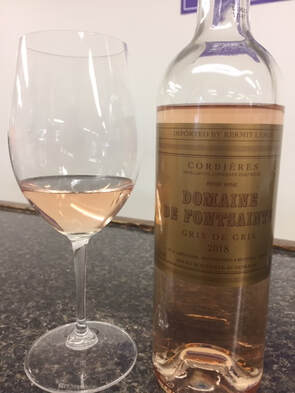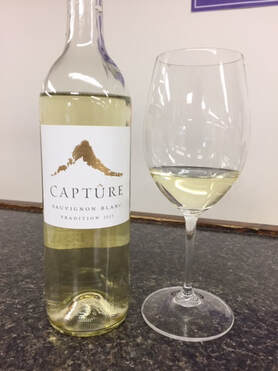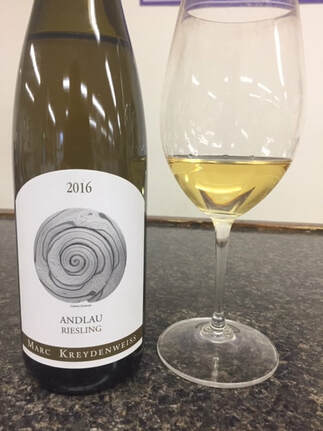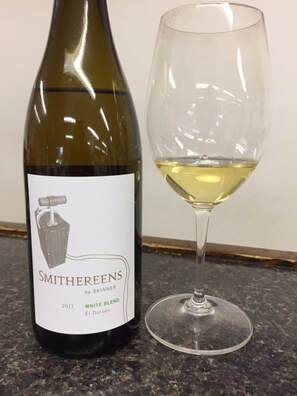 Post Memorial Day is 'officially' when Rose drinking season gets into full swing, as the majority of the really interesting and unique wines from around the world have made it to our shores or out of the wineries, had time to rest properly after bottling or travel, and truly show their stuff. Year in and year out, this is our time to help re-educate the public about the enjoyment and diversity of DRY Rose wines, and this long time classic from importer Kermit Lynch is always Exhibit A. The wine is made from a unique and sparsely planted mutation/clone of Grenache called Grenache Gris, known for having an extremely pale skin with very little pigment. Many wineries in the Languedoc that have it planted will just blend it in with other Grenache based wines, but the historic Domaine de Fontsainte have used the grape's lightness to its advantage in their Rose. Even with a long time soaking on the skin equivalent with the process to make a red wine, the juice barely picks up a pinkish tint, the classic salmon color of Provencal Rose but with a lot more texture. After you taste it, you will wonder why more wineries haven't picked up on this idea. The vibrant salmon color in the glass gives off quick aromas of dried strawberry and cherry skin, but time open gives off more peach and stone fruits as well as some light savory herbs. The palate is where this wine becomes more obviously different, with a rich mouthfilling texture and finely grained tannins to match the bright acidity and juicy watermelon flavors. The aromas and flavors make the wine quenching, while the texture gives it substance and the ability to stand toe to toe with a broader array of dishes that would usually crush the thin spirit of many Provencal roses. Do this with all the classic Summer dishes you would expect a Rose to match with, and include savory pork or poultry into the plans as well.
0 Comments
 We will readily admit to having an inherent bias towards a certain style of Sauvignon Blanc here at Wine Warehouse. The sheer number and diversity of producers in the Loire section of the store, as well as the choices of cooler climate/minerally soil producers in the California section give the not-so subtle hint that we like our Sauv Blanc on the clean and racy side. This isn't to say we don't like the more round, richer and more barrel influenced style as well, it just has to be something we get really excited about. Capture Wines has one that does just that, mixing several vineyard sources in Sonoma County to get the right combination of rich fruit and vibrant citrus from higher elevation sites. Aging the wines on the lees gives the wine a full texture without needing too much time in barrel, which just serves to further polish the edges into a round seamless final product. An almost perfectly clear pale yellow in the glass, the first aromas are cool gooseberries and light citrus, but with air (and a bit of warmth if you've just pulled it out of the fridge) the richer leesy aromas start to appear, giving more creamy lemon curd, pears and white fruit pulp. The palate is at first extremely polished with lots of rich pulpy fruit, but as it sits on the palate gets more grapeskin and melon rind tannins, and grows into a fairly zesty finish. This has lots of back porch and meal time possibilities.for the warm weather ahead  For those that follow basketball, the phrase 'Trust the Process' (copyright pending per Joel Embiid) was coined in Philadelphia to try and give the fans confidence in the team building process management had implemented. Some wineries you have to learn to 'trust the process' as well, believe in the winery and what they do from vintage to vintage is going to be for the best wine possible. Fans of Donkey & Goat Winery have learned to trust their process as one of the best producers of natural wines in America over the last 15 years, and the entry level bottling 'The Gadabout' is the poster child for showing trust. Each year the blend and vineyard sources can change depending on access and quality of the vintage, and they build it to give everyone a more cost effective look into what their wines are all about. Usually the base grapes are white Rhone varieties (Grenache Blanc, Roussanne, Marsanne) but additions and subtractions can happen from year to year. The only constant is their use of organic/Biodynamic grapes, native yeasts for fermentation, and as little sulfur as possible. On the first pop of the cork, the classic 'naturalist' cider tones show through fairly strong, but a few swirls of the glass quickly bring out the more pithy white fruits, melon skins and rich lemon tones. The texture on the palate is plenty rich and full, and the fruits are SUPER zesty, loaded with tangy orange and mouthwatering citrus skins. The sour cidery component that most natural wines carry is evident but does not dominate the vinous character, showing through mostly on the lengthy finish. The longer the wine stays open, the more intense the white fruit tones grow and evolve, genuinely a wine that can improve in the fridge for a couple days thanks to the higher acidity and the skin contact during fermentation. A unique exploration of the natural wine movement, and super tasty for the money.  Many wine drinkers, even long time savvy consumers, get caught in the mistaken old adage that Riesling always makes a sweeter wine. ANY grape variety, red or white, can make a sweeter wine if the maker chooses to. Some are just more adept at it than others, and some are better at disguising their residual sugars and making the taster think the wine is not sweet (we're looking at YOU, Chardonnay!). Riesling suffers from a large glut of less expensive versions from Germany in the market that form a lot of drinker's opinions early on, as well as excellent high quality ones at various sweetness levels. But somehow the driest versions do not register on people's consciousness the same way. Alsace is home to an extremely broad selection of dry white wines from many varieties, and the Rieslings are among the best dry wines in France, full stop. When we got to taste through several wines in the Kreydenweiss lineup recently, we were struck by the absence of any sugary tones throughout his wines, yet were still rich and in balance with the acidity. This is the sort of white wine that should get ALL consumers excited. The Andlau bottling is named after the town around which the vineyards are based, and is blended from several parcels farmed Biodynamically. Though it is their most 'basic' wine, there is nothing simple about it at all. Zesty, almost cider-y apple and cool citrus aromas that develop over time as the classic initial whiff of petrol blows off, as well as a deeper mineral and fleshier apple character. The palate is immediately full and quenching, with mouthwatering salinity and citrus skin texture. Flavors are not quick to arrive, so some time open or even decanting will help things along, but your patience will be rewarded with fleshy, almost creamy baked apple notes and increasingly lengthy mineral and stone fruit character that keep your palate salivating minutes after drinking. All of this and without a single sugary impression to be found, as dry and textured as a Chablis (and more flavorful too). This is a spectacular match with fattier seafood dishes (acidity helps to cut through without overpowering) as well as foods with an Asian influence but not hot/spicy.  If this label looks familiar, we featured the Smithereens Red Blend about 2 months ago. Having just brought in the equally tasty white wine counterpart, we felt it deserves equal billing. To recap from before, El Dorado County is the heart of the California Gold Rush, one of the major historical influences to westward expansion and European immigration in the mid-1800s. The Skinner family established one of the first wineries and distilleries in 1861 and ran a fairly large operation for many years, but faded into an obscure fragment of history until 2006 when a branch of the family picked up the rights to the name and 'rediscovered' the vineyards. Their vineyards focus on Rhone varieties, capitalizing on the dramatic elevation changes along the Sierra Foothills to grow grapes in a variety of conditions to develop great complexity and subtlety in their many blends. The winery's Smithereens series pays tribute to the miners of the Gold Rush using dynamite to blast out gold deposits (not the 80s band of the same name), and is built to be their more basic Cotes du Rhone style wines. This blend focuses on the four most noteworthy white varieties in the Rhone, featuring Roussanne, Marsanne, Viognier and Grenache Blanc in varying ratios based on the vintage. As with the best wines from the Rhone, the blend shows harmony between the four varieties without any one taking an overly prominent position. A touch of the tropical perfume from the Viognier is checked down by the mineral and zesty citrus flower notes of the Roussanne, and the round texture of those varieties are given freshness by the acidity and citrus skin character of the Marsanne and Grenache Blanc. Those that do not like a buttery wine but still want a white wine with some body and complexity should run to try this, a great pairing with more intense seafood and rich pork dishes. |
The Best of the Best.We offering free tastings on these wines in the store every Thursday and Friday, and a 10% discount off the retail price through the duration of the day. Come on by and give them a try! Archives
July 2024
Categories |
Location |
|

 RSS Feed
RSS Feed